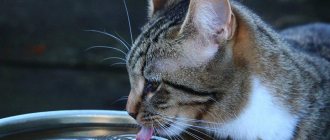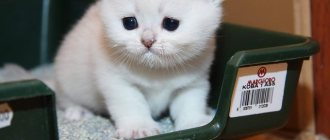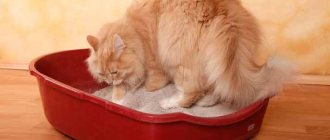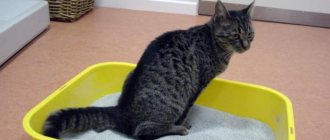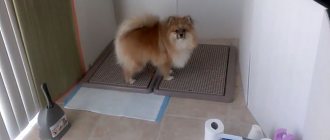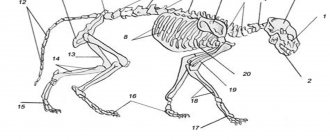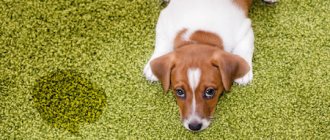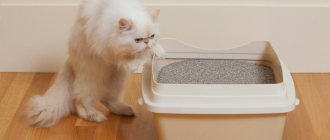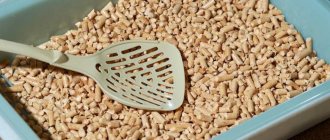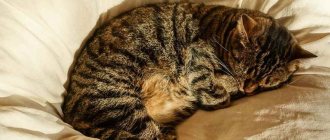How often do cats go to the toilet?
A completely healthy cat should excrete 100 grams of feces per day. At the same time, unlike age, the number of trips to the toilet changes.
It is important to know how many times a cat should visit its litter box:
- up to three weeks, their mother cat provides them with trips to the toilet;
- small kitten aged 3 weeks - three to six times a day;
- up to 4 months – 3-4 times;
- up to a year – 2-3 times;
- over one year old – 1-2 times a day.
Of course, these indicators are affected by the cat’s diet, choice of food or number of feedings. A cat can walk around - less or more times specified, this is all individual. There is no need to feed or give the cat a lot of food. A domestic cat should eat in moderation, in accordance with its age and the recommendations of specialists.
Frequency of visits to the litter box of an adult cat
A cat can be considered relatively mature from the age of 6 months. By this point, internal processes in their bodies usually normalize, and pets also develop their own habits. However, trips to the toilet can still be quite frequent - up to 3 and 5 times, respectively.
The cycle is finally established after a year. It is then that you can clearly trace the number and frequency of visits to the tray, and also notice that they often coincide in time.
Adult cats with a moderate diet go to the toilet “largely” 1-2 times a day.
As for the functioning of the urinary system, everything is somewhat more complicated: it is structured differently in males and females. So, the urinary ducts of cats are much thinner and more tortuous, so they are unable to completely empty their bladder, which, in turn, leads to more frequent sitting in the litter box - up to 4 times a day. Neutered cats go to the toilet even more often, and even 6 trips in 24 hours is considered the norm in their case.
Cats usually go to the litter box 1-2 times a day, but during pregnancy these numbers may be slightly higher.
In rare cases, castrated cats and sterilized cats, characterized by low mobility and laziness, can go to the toilet even once a day without experiencing any problems.
As for quantitative indicators, in a healthy adult animal, on average, the amount of excrement per day can reach 100 grams, and urine - up to 500 milliliters.
How often kittens poop at 1 month is easier to determine, since now this process becomes more pronounced. This happens because at approximately this age, that is, at 3-4 weeks, pets begin to be switched to more solid food. Consequently, the process of defecation also becomes more complex and organized.
At the same time, it is necessary to accustom the baby to the tray. This is how you need to act right from the first emptying, otherwise it will be more difficult to do this in the future.
Monitor your pet's behavior carefully. Usually, before the process of defecation, the behavior of animals acquires certain features. Their so-called “search activity” is activated. They can rush around the room, look for a suitable place to relieve themselves, sniff the space around them and, finally, scratch their paws on the floor.
This is how most kittens behave. However, there are also “quiet people” who silently do their business somewhere in the far corner under the bed. So be careful.
Reasons for frequent visits to the toilet
The main reason why a cat poops frequently is an improper diet. Because of this, the usual functioning of the digestive system is disrupted, it malfunctions and frequent visits to the toilet occur, during which the cat may not necessarily go too far.
Other reasons include:
- Stress . Cats, just like people, can tolerate stress. When moving, sudden changes in environment, early separation from their mother, and other reasons, cats may be in a state of stress. Some people experience this with difficulty bowel movements, while others, on the contrary;
- Wrong nutrition . An animal that does not eat properly may feel discomfort in the body. Heavy foods that take a long time to digest, cause fermentation in the intestines and gas formation, can cause frequent urge to go to the toilet. At the same time, the cat becomes restless, irritable, and his trips are not always crowned with success;
- Constipation . Frequent trips to the toilet in a cat can be directly related to difficulties in defecation. The accumulation of poisoned food, which has already formed in the feces, but for some reason cannot empty the animal’s intestines, causes bloating, abdominal pain and frequent urge to go to the toilet. This happens due to poor nutrition of the pet. The owner simply does not monitor his regime, and this leads to such problems.
Diarrhea in a cat, causes
Diarrhea in cats develops quite often . A one-time loose stool should not frighten the owner, since it is usually a failure that occurs due to minor reasons that do not require a visit to a specialist.
Diarrhea in cats develops quite often
Diarrhea for 2 days or more requires therapy.
There are several main causes of diarrhea in cats:
- Feed intolerance. The animal’s body may not accept the food offered, even when it is of high quality. Most often, the phenomenon is observed when giving low-grade ready-made feed and milk. The problem can be solved by adjusting the diet.
- Sudden change in diet. The cat's intestines and stomach must gradually adapt to the new diet. If it is changed abruptly, diarrhea will easily occur due to irritation of the mucous membrane.
- Worm infestation. The toxins released by worms lead to poisoning, causing loose stools.
- Metabolic disease. This affects most processes in the animal's body, including the number of bowel movements and the density of feces.
- Bowel disease. Diarrhea most often develops with infectious lesions, but may also indicate tumor neoplasms and various ulcerative pathologies. A blood test will be required for diagnosis.
A veterinarian can determine the exact cause of diarrhea in a cat after an examination.
Solving the problem of frequent visits to the toilet
Every owner should know what to do in such situations.
Initially, you need to find out why your pet visits the litter box so often. It is worth analyzing the last week of his life.
Very important:
- review his diet. Reduce your intake of fiber and dairy products. It is better to feed cats with natural, fresh food, and following the advice of experts;
- provide him with a sufficient amount of drinking water and do not prohibit him from drinking as much as he wants;
- for constipation, you can insert a small piece of plain soap into the anus, this will help empty the intestines.
It is best to seek help from a doctor who will help, find out exactly the cause, and possibly provide the necessary treatment.
The article describes one of the problems that often arises among owners of four-legged and very cute pets and suggests possible solutions to it, but you need to remember that only a veterinarian can give practical advice.
Why doesn't my cat go to the toilet all day long?
There may be several reasons why a cat does not go to the toilet: • the pet drinks little liquid; • problems with urination passed on from parents; • disease – urinary tract obstruction; • poor diet, large amounts of fish, salty foods; • overweight; • stress.
How should a cat go to the toilet all day and how many times in general?
The norm for an adult cat is to go to the toilet at least 2 times a day, and at least 1-2 times a day for a large cat. Once every 2 days is considered normal.
What to do if your cat goes to the toilet anywhere and loosely if she is old
If a cat does not go to the toilet in the tray, it is because: • the tray is dirty; • bad place for a toilet; • stress; • like another place; • the tray is closed.
If a kitten goes to the toilet with mucus and clear mucus comes out, what to do?
This problem occurs due to problems with the liver, and if it is also mixed with blood, then these can be kidney stones.
If a cat goes to the toilet next to the litter box or past it, should you punish it or not and how to wean it off
You should not punish your pet; you need to be patient and teach the cat to go to the litter box.
The cat goes to the toilet only when the owner comes, after an enema, on the street, in the morning, at night
Just as a cat is trained, it goes to the toilet. Sometimes out of spite, he waits for his owners and goes to the toilet, perhaps because he is very neat and wants to be cleaned up after him right away.
Why does a cat ride on its butt after using the toilet?
The main reason a cat rides on its butt is worms. Blockage of the paraanal glands forces the cat to ride on its butt to clear the glands.
The cat does not go to the toilet in a strange and new place
This is due to a stressful state; the cat is frightened by new smells and noises. This behavior is normal; owners need to be patient and monitor the pet. Gradually the animal will calm down and everything will work out.
A cat goes to the toilet every other day, two, three, four days, a week, is this normal or not?
If a horse does not go to the toilet for more than 2 days, then this is already a violation and you need to contact a veterinarian.
If a cat goes to the toilet mostly in the bathroom, how to stop it?
To do this, you can fill the bathtub with water, then the cat will not climb into it. The smell of citrus fruits or food also helps; cats don’t shit near food.
If a cat goes to the toilet with blood for a big reason
This deviation from the norm is caused by gastrointestinal disease, allergies, cancer, damage to the anus. Constipation, intestinal obstruction.
Why does a cat drink a lot of water and go to the toilet often?
This behavior is caused by poor quality food, infectious diseases, and inflammation of the bladder.
How a cat goes to the toilet after sterilization with a blanket
It is possible that the cat will not go to the toilet for a couple of days due to fear, but then everything will work out. If the owner is worried, then you need to contact a veterinarian.
Unfortunately, there are often situations when a cat does not go to the toilet in a big way. This causes concern not only for the cat, but also for its owner, since he does not know how to help the pet, what to do in this situation. You should not hope that the problem will be resolved on its own, self-healing will not occur, and the animal will suffer. In this article we will tell you why a cat cannot go to the toilet, and how to help him with this delicate issue.
Frequency of bowel movements
From time to time, babies have problems with constipation, and they may not be able to cope with bowel movements on their own. If the animal does not poop for 2 days, you should be wary.
Often the reason lies in improper feeding. It is necessary to follow the recommendations of the breeder or veterinarian, introduce new food gradually, and do not forget to drink plenty of fluids.
Stress from moving can cause constipation in a small pet; increased attention from the owner will help here. The little ones will need a gentle circular (clockwise) tummy massage.
Very young kittens (up to 3-4 weeks) feed exclusively on mother's milk. Their digestive system is not yet very developed, so there is no need to talk about any regularity.
Starting from the age of one month, kittens learn to drink milk from a saucer and gradually become interested in other foods, including solids. In addition, at this age their digestion is improving, so, although irregularly, they need to go to the toilet. On average, up to three months, a kitten can go to the toilet from 1 to 3 times a day, both “big” and “small”
Starting from 3 months of age, the process of going to the toilet should gradually normalize and become regular. The acceptable maximum can be considered 3 “piles” and 6 “puddles”. The high activity of the kitten has a big influence here, because at this age he constantly plays and runs around a lot, which is why he drinks a lot.
It doesn’t always turn out that a small pet grows up next to its mother. In this case, you should become the baby's mother.
It is you who will have to feed the animal and help it with bowel movements. It should be remembered that food for a kitten up to a month should only be liquid or semi-liquid. This has a significant impact on the process of emptying it. If you do not know what to feed a one-month-old kitten, it is better to contact a veterinary pharmacy. There they will help you choose the optimal “baby” food for your ward.
If you don't know how often little kittens poop, pay attention to the appearance of their bellies. When it is swollen, it means that the baby has problems with bowel movements. Perhaps he simply cannot yet, due to his age, do without outside help.
A bloated stomach will cause him pain. You are required to gently massage his abdomen, avoiding strong pressure. Then you need to take a piece of gauze and soak it in warm water. Use the device to slowly massage the outlet of the rectum. These manipulations should help the kitten begin to relieve itself. Perhaps in the future he will no longer need your help.
If symptoms are detected, you must contact a veterinarian who will determine the cause of the disease.
You can’t just force your pet to go to the toilet in small or large ways. To fix the problem, you need to find out its root source. If the influence of pathological factors is excluded, and additional symptoms are present, it is recommended to consult a veterinarian. The cat should go to the litter box quickly, and the emptying process should not cause discomfort.
READ How many nipples do cats and kittens have?
A cat should poop at least once a day; if this does not happen and the pet behaves restlessly, this indicates constipation. There are several ways to help an animal:
- Use of oil. Give the cat 0.5 teaspoon of herbal product once a day.
- Medications. If there are problems with stool, the veterinarian will prescribe laxatives for the cat.
- Using an enema. The procedure can be performed at home or in a veterinary clinic. Manipulation is done only if constipation is caused by poor nutrition, and not by volvulus or an inflammatory reaction.
If the owner notices that the cat has stopped going to the toilet to pee or the daily amount of urine has decreased, then first find out what the problem is. Perhaps the reluctance to visit the toilet is due to unsuitable filler or its poor quality. In this case, it is enough to change the product. It is more difficult to help an animal when impaired urination is associated with a disease. The sick cat then requires special medications prescribed by the veterinarian.
Why doesn't the kitten go to the toilet?
Let's try to figure out why a little kitten doesn't go to the toilet. There are several reasons why a kitten may not go to bed:
- Firstly, it is stress due to a change in environment. As soon as he finds himself in a new home, he does not go to the litter box for the first 2-3 days. And this is normal, but if there is no stool for about 5 days, then the baby needs help.
- Another reason is the inexperience of the mother cat. As you know, in the first month of a baby’s life, feces are released only thanks to the efforts of the cat. If, due to inexperience or for other reasons, she refuses to massage the kitten’s tummy, then he accordingly cannot go big.
- An early transition to natural nutrition can negatively affect the health of the baby’s digestive system. Ideally, it would be if the kitten switched to full nutrition gradually, while still feeding on the milk of the mother cat.
- Congenital intestinal pathology does not allow the kitten to defecate calmly; in this case, urgent veterinary intervention cannot be avoided.
Possible problems with urination and defecation in kittens
Kittens begin to go to the toilet from birth.
However, the owner may not notice this, because the mother cat quickly licks the feces with her tongue. She uses her tongue to help her baby poop and pee, licking the belly, anus and genitals with her tongue. The warmth of the tongue, its rough surface and circular massaging movements stimulate digestion and relax the sphincter.
The first few weeks it is difficult to count the number of trips to the toilet, but then you should monitor the frequency of bowel movements. Severe deviations from the norm are signs of diseases of the genitourinary system or gastrointestinal tract, and are also a reason to take your pet to the veterinarian.
It is important to remember that the amount of fluid emitted should be proportional to the amount of fluid drunk. If your pet drinks a lot of water, he will walk more often.
Up to one and a half months, the cub should walk 3-6 times a day. It is necessary to observe the stool itself: soft, formed stools are considered the norm. By 3 months, feces become harder, and trips to the litter box are reduced to 1-2 times a day.
If a pet eats food high in protein (meat, milk, eggs), the number of bowel movements is less than if the diet is dominated by plant foods (cereals, vegetables). When getting accustomed to ready-made food, you should pay attention to the composition of the food in order to regulate stool. Economy class food contains a lot of fiber, but little animal protein, so it is not suitable for kittens: the food will not be absorbed by the body, but will be released along with waste.
The kittens are eating.
The composition of feces directly depends on what and how the kitten eats. There must always be water in the saucer, even if the pet drinks milk. If there is mucus, lumps, or pieces of undigested food in the stool, you should consult a veterinarian regarding your pet’s diet.
If your kitten pees every time he drinks water or milk, don't worry. He may be eating a lot of dry or salty foods, which causes his body to require more fluid for normal digestion. The smaller the animal, the smaller its bladder, but with age the number of urinations decreases.
By 2-3 months, the cat should pee on average no more than 5 times a day. Otherwise, it is recommended to have a preventive examination by a veterinarian. The reason for frequent trips to the tray may be poor-quality food, which disrupts the functioning of the genitourinary system.
It is necessary to check the living conditions of the pet. Favorable conditions for a cat are the following:
- room temperature within 18... 26°C;
- no stress factors: loud noise, children, scary toys, other animals;
- The food is balanced and intended for kittens.
The kitten pees often.
Inexperienced owners may think that their pet does not go to the toilet until almost a month old, because they do not find traces of vital activity on the litter. However, like any living organism, the kitten empties its intestines and bladder.
This happens from the very moment of birth, but the cat helps babies go to the toilet by massaging the cubs’ stomach and anal area with their tongue, stimulating defecation. After the cub has done its business, the mother licks the urine and stool, which has a consistency similar to a thick paste.
Each period has its own defecation norms. Before 3 weeks of age, a healthy animal usually poops 3-6 times a day. The tummy should be soft and toned. The stool has a mushy consistency.
Each period has its own defecation norms.
If it contains mucus, blood, undigested food, or is too dry or greasy, then this is a reason for the animal to be examined by a veterinarian. When calculating, you should understand that babies can sometimes relieve themselves in the most secluded place.
As a cat grows, its nutrition changes, the thickness and density of feces increases, and feces become almost the same as those of adult animals. The number of visits to the tray is largely determined by what is included in the diet.
If it contains more plant fiber, then the kitten will poop less than when fed food with a predominance of proteins. Typically, a grown animal defecates 2-3 times a day.
If a situation arises that your pet begins to go to the litter box too often, you should pay attention to this disruption of the body’s functioning and visit a veterinarian. A constant urge to urinate may indicate that your pet has a disease of the genitourinary system.
If your pet starts going to the litter box too often, you should pay attention to this.
The reason may lie in a stressful situation or increased water consumption. Cats may suffer from urinary incontinence or may simply be marking their territory.
Diseases are provoked by the following factors:
- the presence of pathogenic viruses or bacteria in the body;
- overfeeding;
- recent sterilization;
- breed susceptible to diseases (Scots, Persians, Siamese);
- excess water.
If blood is detected in your pet’s urine, you should contact a veterinarian who will diagnose and prescribe treatment:
- a course of antibiotics;
- antiparasitic agents;
- antispasmodics;
- diuretics;
- insulin therapy (when diagnosing diabetes mellitus).
If the reason for frequent trips to the litter box is stress, then the owner’s task is to protect the pet from the source of trouble. To eliminate a lack or excess of moisture, it is necessary for the kitten to drink 3 times the amount of food eaten.
Normal bowel movements in a kitten depend on a number of factors. The most important is age. Gender and health indicators are equally important.
There is a difference between males and females. Cats often go to the litter box in small sizes. This is due to the physiological structure of the urinary tract; they are narrower and longer than those of females.
In the first three weeks after birth, the cat takes care of the kitten's toilet. From the outside it may seem that newborn kittens do not defecate at all. The mother monitors the hygiene of her cubs and licks off any secretions, cleaning out impurities. The cat massages with its tongue, stimulating the digestion process of newborn kittens. This helps them pass stool. In addition, gas formation in the small belly is reduced.
In the first weeks of life, the baby's toilet is monitored by the mother cat.
If kittens are left without a mother for some reason, they cannot go to the toilet on their own, which is why they can die. When kids find themselves in such a situation, they definitely need help. A regular cotton swab dipped in warm water is suitable for this. They are given a light abdominal massage. It is important not to press, but simply move the tampon in different directions.
A small kitten must be properly cared for so that it can develop and grow normally. If he is separated from his mother and finds himself in the house of a new owner, then the adaptation period may be accompanied by stress. A number of negative factors can affect the weakening of an animal’s immunity. This affects the functioning of all body systems. Absence or problems with urination and bowel movements during this period are quite acceptable.
We invite you to read: How many cat breeds exist in the world?
When the kitten has grown up and settled down, has become the owner of an excellent appetite, but does not go to the toilet properly, it is worth wondering if everything is okay with him.
Constipation in a kitten
The following disorders can cause constipation in kittens:
- Stressful state. Stress can be triggered by a variety of factors. For example, a visit to the veterinarian, the presence of other animals in the house. However, the most common is a change of residence. The kitten may not have a bowel movement for two to three days. Then everything returns to normal.
- The cat was separated too early. During this period, when the kitten misses its mother's closeness, the absence of stool may last for 4–5 days. If after this period the situation does not change, then you should seek help from a specialist.
- Wrong diet. If the baby ate natural food before he got to his new home, then you cannot suddenly switch him to dry food. Constipation in a kitten can be caused by too much protein in the diet.
- Worms. Intestinal parasites can cause intestinal blockages. This is a dangerous condition that requires medical attention.
If your baby cannot have a bowel movement for more than five days, he needs help. There are a number of recommendations:
- Microclyster. The procedure is allowed if there are no contraindications, that is, if constipation was caused by an unbalanced diet, and not by a violation of the digestive system.
- Enzyme preparations.
Prebiotics can be given to a kitten only after prior consultation with a specialist. Mild laxatives prescribed by a veterinarian may also help (medicines for humans are not suitable). Enzyme preparations must be prescribed by a veterinarian - Oils. You can add a few drops of oil to your baby's food. Vaseline is the best option, since it cannot be absorbed into the gastrointestinal tract and does not overload the animal’s liver.
I recently learned about Vaseline oil for cats, but have already tried it. You only need a little bit of it, it’s completely unnoticeable with the kitten’s food. But it helps him go to the toilet, like a mild laxative. But others are not recommended to replace it. The same olive oil is absorbed into the gastrointestinal tract and adversely affects the liver.
Frequent stool
Spontaneous reflex to urination and stool in babies occurs at three weeks of age
Why doesn't an adult animal go to the toilet in a big way?
To help their pet, the owner must know what factors lead to the fact that the cat does not go to the toilet in a big way. The most common reasons leading to problems with bowel movements:
- Improperly balanced diet. When a cat eats food with a low protein and fiber content, he experiences stool retention, which is also observed when he abuses bones and drinks a small amount of liquid.
- A long-haired cat does not go to the toilet due to the presence of hair in the gastrointestinal tract, which enters the pet's stomach in considerable quantities as a result of the desire for cleanliness. Simply put, hairs that get inside are connected in the form of lumps and create great obstacles both for bowel movements and for the formation of feces.
- Stressful situations can arise not only in a kitten that has just been weaned from its mother cat, but also in an adult animal as a result of an encounter with a dog, a trip on public transport, or the arrival of noisy guests with small children.
- In old age, deterioration of the gastrointestinal tract occurs. The intestines cannot work in the same mode and do a poor job of pushing feces through their departments.
- Neutered cats tend to be obese, they are lazier, prefer to lie down more and are hungry all the time. These factors lead to obesity, which negatively affects the process of bowel movements.
- Diseases of the internal organs can make it difficult to pass stool.
How many times a day does a kitten pee
Babies begin to write from birth. The bladder in newborns is very small, so as much fluid enters the tummy, approximately the same amount should come out in the form of urine.
READ Aquarium frog - albino who is it
The rate of urination in the litter box in babies is 10 times a day, decreasing by 3 months of life to 5-6 urinations, and up to 2-3 times in adult animals.
The frequency also depends on the sex of the animal. Boys have narrower urethra than girls, so they urinate more often (up to about 5 times a day). It is necessary to ensure that the urine is clean (no mucus, blood, cloudiness) and that the process of urination is painless.
Be sure to read:
How many times should a cat go to the toilet, small and large?
While getting used to a new home, the animal often experiences stress, and for the first few days it may pee somewhat less frequently.
How can you solve a pet’s delicate problem at home?
When a cat cannot go to bed, she needs to consult a veterinarian, but if it is impossible to organize a trip to the clinic, then you can try using home remedies:
- First, you need to pay attention to what your pet eats. You need to include vegetables, kefir, and milk in your diet.
- You can add 5 drops of Vaseline oil to your cat's food. It is completely harmless to health and has a softening effect. Vaseline oil should not be replaced with vegetable oil, as the latter has a negative effect on the pet’s liver.
- As a last resort, you can give the cat a laxative, for example, Duphalac, Lactusan.
- Sometimes you can relieve your cat's condition with an enema. Doing an enema at home is not recommended. Frequent use of these measures is also prohibited, as they can lead to weakening of the intestinal muscles and the formation of chronic constipation.
- Experienced cat breeders recommend that if the cat does not walk for several days, include condensed milk in the food, dissolved in running water, in a ratio of 3 parts water to 3 parts condensed milk. You need to drink 1 tablespoon per hour. You should not give it more than 5 times a day, as the high sugar content has a detrimental effect on the pet’s body. Condensed milk dissolved in water will loosen the tummy and make bowel movements easier.
- A small kitten can be helped by massaging the tummy, which is performed by gently moving it around the clock cage with a cotton pad dipped in warm water.
- Preparations that help normalize the intestinal microflora, for example, bifidumbacterin or lactobacterin, are good for eliminating problems with stool.
Dietary recommendations for a constipated cat
In the question of what to do when a pet does not walk for several days, a therapeutic diet can help, which includes the following diet:
- Soups, cereals, soaked dry food.
- It is best to mix boiled vegetables with the animal’s food, because it is rare for a cat to eat vegetables separately. Zucchini, beets, and pumpkin are good for these purposes.
- Fermented milk products help normalize the digestion process and combat stool problems.
- Raw liver or fish are rarely recommended for your pet.
You should not give a cat suffering from stool retention chicken, chicken broth, rice, eggs, or boiled meat. If a cat eats these foods, he often experiences defecation problems. For cats that do not go to the toilet for several days, specialized food is recommended, which is best selected from a veterinarian.
When a kitten does not go to the toilet for more than 6 days, it is better to find out from the previous owners what the baby eats and give him this food. After 3-4 days, you can gradually add new ingredients, for example, finely chopped meat, it contains proteins and can help solve the problem of feces.
Prevention of lack of stool in cats
To prevent cats from having defecation retention, preventive measures must be taken. Firstly, you need to review the animal’s diet and pay attention to what the pet eats during the day. You should not feed your pet from the table. A cat who eats food of excellent quality does not suffer from stool retention. When the owner gives him natural food, he needs to create a diet that contains meat and vegetables. If a cat eats steamed bran, it has a good effect on the functioning of the digestive system.
Cats are fairly clean creatures who always willingly take care of their fur. To prevent your cat from swallowing it, you need to do regular brushing. Pet stores also have products that help remove hairballs from the gastrointestinal tract.
As a rule, neutered cats tend to have a recumbent lifestyle. The less the pet moves during the day, the worse it goes to the toilet. When an animal is given balls, toys, climbing machines, and taken for a walk, then, as a rule, he does not have problems with peristalsis.
How often should a cat go to the toilet?
Ideally, an adult animal should go to the toilet at least once every 2 days. When a cat eats dry food, it visits the tray 1 to 3 times a day. Older animals, over 9 years old, go to the litter tray every other day. A pet that eats food containing fiber and protein can defecate up to 3 times a day. How long a barbel should normally go to the litter tray depends on its nutrition. However, when a cat does not go to the toilet for longer than 4 days, you need to visit a veterinarian.
In conclusion, we can say that you should not rely on chance. If a cat’s defecation delay is not an isolated phenomenon, then it is necessary to consult a specialist who will give recommendations on the choice of medication, determine the cause that caused this condition, and tell the owner what to do to alleviate the animal’s condition.
Sometimes cat owners encounter such a delicate problem as constipation in their animal. A bowel movement at least once a day is considered normal. If it is less frequent, or the cat constantly defecates heavily, then this is the first sign of constipation.
What should be normal
The function of emptying the bladder and intestines is assessed using various indicators:
- First of all, frequency. “In a big way” a cat should go to the toilet at least 1 time a day (the lower limit of the norm is 1 time in 2 days), “in a small way” – 2-3 times a day. Anything less is constipation (in the case of a decrease in the frequency of bowel movements) and oliguria (a decrease in urine output).
- The second criterion for normality is painlessness. The act of defecation and urination should not be accompanied by pain. Pain in this process is not physiological.
- The third criterion is the absence of impurities in feces or urine. If a cat cannot pass a big bowel movement, but blood or mucus is released from the anus, this is a pathology. The same applies to blood in the urine.
Constipation in a cat
If a cat does not go to the toilet for a long time and meows near the litter box, it is constipated. Need to do something! Read below.
Constipation is a common problem in the animal’s body, and it is associated with disruption of the digestive system.
If you notice that your cat sits on the tray longer than usual, scrapes the litter with its paws, and sometimes even screams loudly, this means that your pet has problems with bowel movements.
A healthy cat should walk at least once a day!
A healthy cat has bowel movements once or twice a day . Other deviations from this norm will indicate incipient constipation.
Constipation symptoms
Bloating can lead to constipation and more serious complications.
When a cat cannot go to the litter tray for a long time, its behavior and mood changes. Symptoms of constipation are as follows:
- The pet's belly is swollen and hard to the touch.
- Loss of appetite.
- A long and fruitless stay on the tray.
- Digging in the filler, loud screams.
- Rare hard and dry feces.
- Lack of playful mood.
If you notice such symptoms in your pet, you should not try to help him yourself, as this is a very serious problem. You should immediately consult a doctor so that he can help your animal. You shouldn’t delay this either, since there are known cases of deaths.
Norm or pathology
Normally, a cat should go to the toilet no more than twice a day. The feces of a healthy pet are formed, brown, and soft.
If a cat has diarrhea, the number of visits to the toilet increases sharply (up to 10 times a day). The stool becomes thin, watery, smells bad, and the color of the stool often changes.
Diarrhea in a cat can last from one day to several weeks or occur periodically over many months.
It is customary to divide feline diarrhea into three forms:
- Acute – lasts several days, but no more than 2 weeks. There is a high risk of dehydration.
- Chronic – more than 2 weeks. With constant diarrhea, nutrients and vitamins are poorly absorbed. This leads to weakened immunity and exhaustion. Without adequate treatment, the animal will not get better.
- Constant or recurrent - loose stools occur periodically in a cat for a month or more.
To choose effective treatment, you need to find out the cause of the disorder.
Prolonged loose stool in a cat leads to water and electrolyte imbalance, which can result in the death of the animal. Therefore, the help of a veterinarian is required.
Why the cat doesn't go to the toilet for a reason (reasons)
Wool could get into the stomach when washing. This is serious and can cause a blockage.
Any owner, of course, wants to know what causes constipation in a cat in order to avoid this in the future. The most common reasons are:
- Protein-free food.
- Licked fur accumulated in the stomach.
- Dehydration.
- Inflammation or cyst in the intestines.
- Foreign body in the stomach.
- Consequence of taking medications.
- Obesity.
- Old animals that don't move much.
- Stress.
What to do?
A mother cat helps kittens cope with constipation. How to help an adult cat?
Mother cats help little kittens with constipation. They lick them, thereby relaxing the tummy, and bowel movement occurs.
If you take home a small animal, most likely it will be difficult for him to cope with such a problem on his own, so you can help him yourself. Place the kitten on your lap, tummy up.
Performing a tummy massage on a kitten.
Stroke your belly clockwise and from top to bottom. This way, you can release any accumulated gas, which should help your pet.
How many days can a big kitten not walk around (stress when moving)
With stress associated with moving a small creature to a new home, stool may not pass for 3-5 days , and this is the norm, but only for small kittens.
Helping adult cats
Mix running water with condensed milk and give it to your cat. This will help with minor bowel problems.
Adult animals can be helped by adding a little vegetable oil or Vaseline oil to their food. You can use mild laxatives. There is also popular advice on cleansing the intestines. Mix boiled or running water with condensed milk, and feed the resulting mixture to the animal. This mixture should help your pet if constipation is still in the early stages.
If all of the above does not help, you should immediately contact your veterinarian.
Help for constipation in hospital
Upon admission to the veterinary hospital, the animal is thoroughly examined.
The doctor will examine your animal visually and then prescribe appropriate tests. Most often, a blood test is enough to detect inflammation in the body. If a foreign body or hairballs are suspected, an ultrasound or X-ray is prescribed.
Enema appointment
It is necessary to give an enema to a cat with great care, as it can damage the rectum from the inside.
Once the cause is identified, an enema may help the animal. Many owners try to do it themselves at home, but this is dangerous , as you can damage the rectum from the inside. Therefore, it is recommended to perform an enema only under the supervision of a veterinarian. The doctor can also prescribe laxatives to the animal and prescribe a diet in the form of a healthy diet.
If more serious causes of constipation are identified, a course of treatment with medications may be required. In more advanced cases, surgery may be required to clean out the stool.
Often constipation is a harbinger of serious diseases such as diabetes mellitus, intestinal obstruction, hernia and thyrotoxicosis.
The cat does not go to the toilet after sterilization
Constipation after sterilization is quite common. After anesthesia, the body takes a long time to regain consciousness.
Constipation after such operations affects cats more often than cats, due to the physiological characteristics of each sex. In general, the pet tolerates the operation itself well, but anesthesia can leave consequences. When exposed to it, the functioning of the animal’s organs slows down. The organs recover from anesthesia gradually.
After anesthesia, a cat may ask for water or food, but its stomach and intestines have not yet resumed functioning at full capacity, which is why constipation may occur.
To prevent this from happening, you should not feed your cat 12 hours before sterilization .
Constipation after surgery
It is not uncommon in such cases that the veterinarian prescribes Duphallac.
After the operation itself, it is better to abstain from eating a little until the animal fully recovers; it is better to limit itself to drinking only. Constipation after sterilization is dangerous because the animal, when pushing, can damage the wound from the operation. Bleeding may occur or the stitches will come apart.
Therefore, after sterilization, while the stitches have not yet healed, it is better to monitor the cat’s nutrition.
You should not give her anything that will fix the stool; it is better to feed her liquid food in small portions. If constipation does occur, then it is better to give your pet the laxative “ Dufalac ” or Vaseline oil. You can buy it at the pharmacy. Vaseline oil is not absorbed into the cat’s body, makes the intestinal walls elastic and softens the feces.
After castration
To relieve constipation after castration or sterilization, the animal should not be given vegetable and castor oil. Vegetable oils are quickly absorbed into the body, and this method will be useless. Castor oil can cause severe gastrointestinal upset in a cat .
After childbirth
After giving birth, your cat may become constipated. Vaseline oil will help her. But if stool does not return within 24 hours, then you should consult a doctor, as complications after childbirth are possible.
Preventing constipation in cats
Human food can cause problems for a cat to go big.
To ensure that your cat never has problems with stool, you need to monitor the condition and behavior of your animal. You should brush your cat regularly, especially if it is furry. Try to prevent inedible objects from falling into the paws of cats: beads, ribbons, laces, bones, etc.
The basis for combating constipation is a healthy and balanced diet for the animal. Regarding food, you must follow the following rules:
- Do not feed your pet the same food you eat yourself. Human food is not always suitable for cats .
- The food you feed your cat should not be very cold or hot . Liquid and warm foods are best for normal bowel function.
- Sometimes for constipation, the veterinarian prescribes a special food that helps get rid of this delicate problem. You should know that this food should not become your pet’s main food. It should be included in the diet as a supplement to his daily nutrition.
Food for proper bowel function
For normal intestinal function, food enriched with proteins and fiber is necessary. Eliminate cheeses, rice, eggs and flour products from your cat's diet. The animal must have constant access to a bowl of water to prevent dehydration. Physical activity is beneficial. If the cat is lazy and likes to sleep all day. Take him for a walk, play with a feather or a ball.
Preventing constipation and diarrhea
Another, no less unpleasant defecation disorder in kittens is diarrhea.
Before diagnosing your pet, you need to figure out how often kittens poop and whether it’s diarrhea at all. Many owners believe that if a kitten’s stool becomes liquid, then this is diarrhea. However, it is not.
Diarrhea is not only watery stool consistency, but also a frequent urge to defecate. An additional symptom may also be bloating.
The causes of diarrhea in an animal can be helminthic infestations, poor nutrition, infectious and inflammatory diseases. On a psychological level, early separation of a kitten from its mother can provoke diarrhea.
If a kitten has diarrhea, it is advisable not to feed it for about 12 hours, but to give it only water. By the way, he must drink. Not drinking water can lead to dehydration.
In this case, a sorbent such as “Smecta” or “Enterosgel” can be used as a medicine.
If attacks of diarrhea no longer recur, then after 12 hours the pet can be fed. First, a little boiled rice or three-day (!) kefir is given. Fresh fermented milk products can only worsen the situation. The next day, boiled chicken meat, and so on, expanding the diet.
In any case, self-medication is not recommended for either people or animals. Therefore, if there are various disturbances in the process of relieving yourself in your little family member, you need to show him to the veterinarian.
You've already learned how often kittens poop and how to care for them. A loving owner should also take care of preventing problems with bowel movements. To do this you need:
- comb the animal regularly so that excess hair does not clog the intestines when licking;
- give kittens phytomines to cleanse the intestines;
- feed your pet a variety of foods, using foods rich in fiber;
- give space for your pet’s active life, which improves intestinal motility;
- contact your veterinarian in time.

